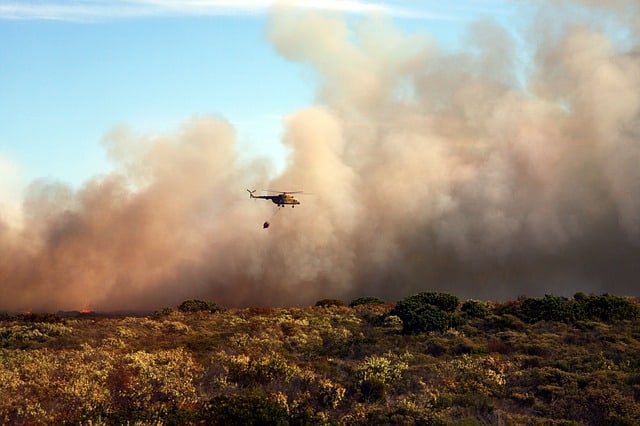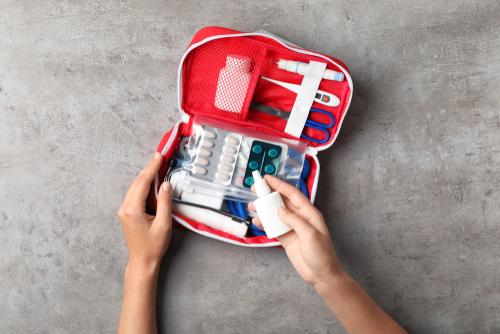Fire is the type of disaster that no one wants to imagine striking their home. Unfortunately, there is an average of more than 355,000 residential structure fires each year and seven Americans lose their lives in home fires every day. These disasters can be caused by numerous things, including cooking accidents, faulty heating or electrical systems, etc. To make matters even worse, wildfires are becoming increasingly common threats. In 2018 alone, there were 58,083 wildfires which burned roughly 8.8 million acres and destroyed numerous homes.

While there are things you can do to make your home a safer place to prevent fires, there is little you can do to prevent them if you are in the path of a wildfire. There are, however, things that you can do to prepare for this type of emergency.
Fires are often devastating and it’s virtually impossible to be fully prepared for one. By ensuring that you have a fire emergency kit, however, you can make it a bit easier for you and your family to escape and recover. Keep reading to learn more about a few essential items you need for your home’s fire emergency kit.
Also Read: Disaster Survival Skills for Any Emergency Situation
Water and Food
When disaster strikes, having enough water and food is vital. This is especially true when you are forced to evacuate due to a wildfire. You may be unable to go to a grocery store to purchase the supplies you need, so you need to have them on hand.
Store at three days’ worth of water in plastic containers. You will need at least one gallon of water per person, per day. You need a three-day supply of food, too. Stock up on non-perishable foods that are easy to store and transport, such as granola bars and trail mix. It’s also smart to have ready-to-eat canned vegetables, fruits, meats and soup. Shelf-stable milk and juices are good, too. Don’t forget to include a non-electric can opener. If you need to heat your food, you’ll also need Sterno cans.
If you have small children in your home, don’t forget to include the foods that they need. You’ll need food for your pets, too. Replace your stored food and water every six months.
First Aid Kit

Put together a first aid kit that includes a selection of supplies, such as adhesive bandages in various sizes, gauze pads, hypoallergenic tape, scissors, roller bandages, tweezers, alcohol wipes, hand sanitizer, latex gloves, antiseptic rinse, antibiotic ointment, etc. Your kit should also contain a selection of over-the-counter medications, including pain relievers, anti-diarrhoea medicine, laxatives and antacids. You may also want to include allergy pills or cold medicine. Pack at least a three-day supply of prescription medications, too. If you wear glasses or contacts, include a few pairs of contacts and/or an old pair of glasses along with necessary cleaning supplies.
Hygiene and Sanitation Products
Make sure your kit includes toilet paper, moist towelettes, soap, plastic garbage bags and ties, a plastic bucket with a tight-fitting lid, disinfectant and chlorine bleach. These items can help with sanitation if you do not have access to a restroom. Include personal hygiene items, too, including bar soap, shampoo, conditioner, toothpaste, deodorant, a toothbrush and a brush or comb for your hair. If you or anyone in your family has long hair, hair ties are good, too. Be sure to pack feminine hygiene products for the women in your family and any additional supplies that you may need for infants or elderly household members.
Tools and Supplies
If you are displaced from your home by a fire, you may need certain tools and supplies. Make sure your kit includes a battery-operated radio and flashlight and plenty of extra batteries, a non-electric can opener, a utility knife, a fire extinguisher, pliers, duct tape, a small sewing kit and plastic sheeting. Also, make sure you have a shut-off wrench that you can use to turn off your home’s gas.
Keep some cash and traveller’s checks on hand. In the event of a major emergency, such as a wildfire, you may not be able to use a credit card. Keep copies of important documents, including driver’s licenses, social security cards, birth certificates, insurance policies, etc. in your emergency kit, as well.
Clothing and Bedding
Pack blankets or sleeping bags and a pillow for each person so you are prepared in the event of needing to stay in a shelter. You should also include at least one complete change of clothing and footwear per person. Along with basics, such as t-shirts, pack hats and gloves, rain gear, thermal underwear and sturdy work boots or shoes. Buying wholesale clothing is a good way to ensure that you will have what your family needs in the event of an emergency without having to spend a fortune. When you buy bulk clothing, you can also donate the excess to other families who may be in need in the event of an emergency.
Conclusion

Store all of the items listed above in plastic containers in an area that is easily accessible and make sure everyone in your family knows where everything is. Store individual items in airtight plastic bags. Consider making a smaller version of your main kit and keeping it in the trunk of your car. This helps ensure that you will have the bare minimum of what you need even if you need to evacuate and don’t have time to grab your kit.
Update your kit on at least an annual basis. Replace clothing that will no longer fit your kids, switch out your store toiletries for fresh packs, etc. Be sure to update your kit if your medication needs change, too.
Fires are devastating emergencies that no one wants to face. By ensuring that you have a fire emergency kit, however, you can be better prepared in the event of a disaster.
Author Bio: Sarah Cohen is a writer and stay-at-home mother of three children. She loves blogging, crafting, and spending time with her family. She also enjoys the great outdoors and hiking to explore new areas for adventure!
